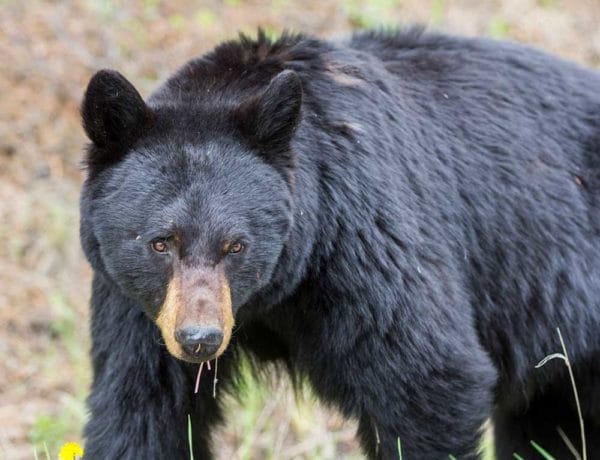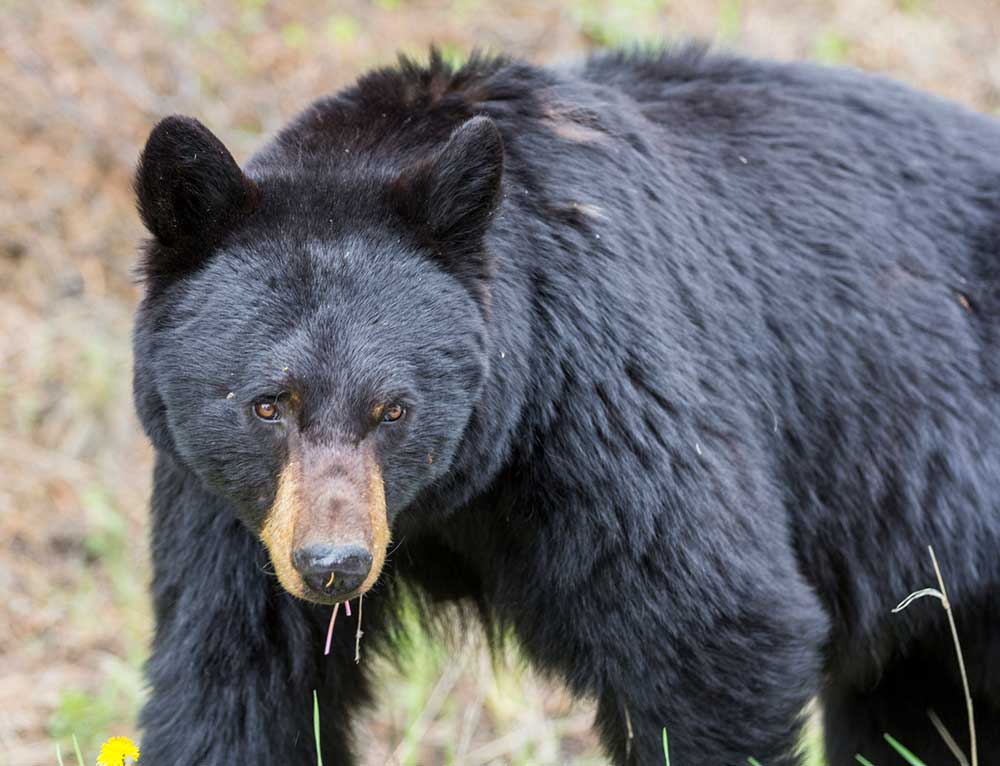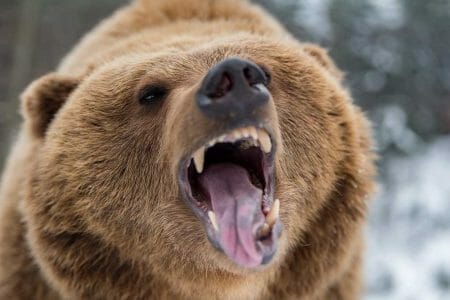
U.S.A. –-(Ammoland.com)- In several cases this summer, there were times where you read what happened and say, they should have had a gun. Fatal bear attacks are rare. Attacks, where someone is injured, happen much more frequently. Close calls, without injury, are more common yet. Here are some cases from this summer where it seems the people involved would have been well served by the availability of a defensive firearm.
It is better for everyone concerned if the attacking animal is killed by the people immediately involved. It takes the authorities time and considerable money to respond.
On 26 June 2019, 54-Year-Old Alex Woods was doing his job, searching for diseased trees in British Columbia, Canada. As he started down a steep slope, alone in the wilderness, he was charged by a 200 lb black bear in a clear, predatory, attack. He tried to access bear spray, but could not get the cap off. He kicked the bear, then was able to access his hatchet. From outside online.com:
“So then the bear dropped down from the tree,” he continues. “And as it was doing that, I’d reached into the back of my vest. The zipper’s broken, so I was able to get at my hatchet fast. But the bear was right back on me by then, so I just sank the hatchet into its head. I was lucky enough that it happened where those trees were, and on a such steep slope. I wouldn’t have been able to kick it otherwise, or get it on the head. Those trees slowed it down, and fortunately I didn’t struggle getting the hatchet out like I struggled with the bear spray. But also, if it wasn’t for those two charred trees, I’d probably be dead.”
In the reporting, it was suggested that bear spray could have solved the problem. It is far from certain. Black bears have shown considerable ability to shrug off bear-spray and continue predatory attacks. Why leave a bear that considers people to be food, alive in the woods, when the next human it encounters may not be so lucky in circumstance or armament?
Alex would have been better served with almost any handgun. They do not have to weigh more than bear-spray and have been optimized, over hundreds of years, for quick and efficient use under stress. Unfortunately, it is very difficult to obtain the legal permissions required to carry handguns, even in wilderness areas, in British Columbia.
On 12 July 2019, in Vermont, near Glastonbury Mountain, at the Goddard shelter on the Long Trail, multiple hikers had been harassed by a bear acclimated to getting food from humans. The situation got so bad that people piled rocks at the shelter to use to drive off the increasingly aggressive bear. It is a remote area, and cell phone coverage is spotty. The bear was taking backpacks, had come into the shelter while it was occupied by humans, and had charged at least one person. From benningtonbanner.com:
On Friday, wardens returned to the area, and when the bear appeared, it was shot and killed.
“The bear was showing no fear of humans at this point,” said Amsden, who was not one of the responding wardens Friday. “Human safety was now at risk, so we felt it was necessary to put the bear down,” he said. “The remoteness of the area obviously had some challenges for dealing with it.”
In the judgement of the game wardens, the bear had become so “conditioned” — that is, so accustomed to food access — that it wasn’t going to stop coming back.
Fortunately, no one was injured. Multiple people had their backpacking trip turned into an ordeal, where they lost food and had valuable equipment destroyed. Why, in Vermont, where Constitutional Carry has been the rule ever since the Constitution has existed, did no one shoot the bear earlier?
Educated speculation on my part: It is a long hike, and few backpackers feel the need to carry an extra pound or two of firearm and ammunition; Vermont has become rather leftist oriented, a bear shot by a private citizen is likely to engender a serious investigation.
On 22, July, near White Iron Lake in Minnesota, a 16-year-old girl was attacked, from behind, by a black bear, in what appears to have been a predatory attack. Fortunately, she escaped. From duluthnewstribune.com:
“She didn’t see the bear until it started running at her from behind,” said Dan Stark, a large-carnivore specialist for the DNR. “It bit her in the leg, but she was able to pull away from it. She continued to run to try to get away from it, and then it stopped when she reached kind of an opening.”
That same evening, a DNR conservation officer found a bear at a garbage bin near the location of the attack. The bear reportedly showed no fear of people, and the DNR officer killed the animal, a 240-pound male.
While most 16-year-old girls do not carry firearms, many are capable of doing so responsibly. When my daughter was 16, and with me in Arizona, I had her carrying her Glock 19. She said she became very aware of her responsibilities that summer. That was legal in Arizona. It is against Minnesota law for anyone less than 21 to carry a handgun; they are not able to obtain the carry permit required in the state.
On 29 July 2019, again in British Columbia, 45-year-old Cowlin Dowler was attacked by a grizzly bear while mountain biking. He saw the bear in plenty of time to use a firearm if he would have had one with him. He did not. It is very difficult to obtain a permit for a handgun in British Columbia. He talked to the bear. He threw his bike at it. Those attempts did not work. From the independent.co.uk:
Mr Dowler told Canadian broadcaster CBC: “It grabbed me by the stomach and kind of pushed me down and dragged me toward the ditch maybe 50 feet. I tried eye-gouging it away and it didn’t really work.”
The bear also bit into his limbs during the 29 July attack, the reports said.
He added: “It sounded like it was grating my bones up.
“Somehow, I don’t know how I did it. I used both hands to pull underneath the bear to get to that knife, and I grabbed the knife … and stabbed the bear in his neck.
I am sure Mr. Dowler would have preferred to have a handgun over a 2-inch pocket knife in his fight for life. The bear stopped the attack, bleeding profusely. Mr. Dowler was able to walk out until he found some loggers, who gave him aid and contacted emergency responders. As is usual, the bear was tracked down and killed by the authorities.
In the early morning hours of 15 August 2019, a bear grabbed talented musician, Julien Gauthier, 44, from the tent he was sleeping in. His companion did not know he was gone until 7:45 the next morning. He was in the remote Tulita area, on the Mckenzie River in the Northwest Territories. From the nypost.com:
Gauthier was sleeping when the bear suddenly dragged him away sometime in the middle of the night, said Toscani, who realized what happened around 7:45 a.m. Thursday and raised a distress alert, according to the report.
The Royal Canadian Mounted Police searched the largely isolated area, accessible only by sea or air, and found Gauthier’s body the next day, according to the report.
Gauthier, Toscani and another woman, a cellist, had planned to canoe about 930 miles down the Mackenzie River from Fort Providence to Inuvik, according to a crowdfunding page for the project.
Attacks while sleeping are difficult to defend against. When I was hunting in Alaska, I kept a .357 magnum revolver attached to my wrist by a lanyard when I was sleeping in our tent. An electric fence is a good idea when you are in bear country. In the Northwest Territories of Canada, obtaining a permit to carry a revolver is nearly impossible. Authorities have killed two bears that were found near Gauthier’s body, a black and a grizzly, so far.
Finally, on 10 August 2019, a man was attacked by a mountain lion near Kremmling, Colorado. He saw the lion long before the lion pounced. He backed up 200 yards and ended stabbing the lion with a pocket knife. From steamboatpilot.com:
GRANBY — A man attacked by a mountain lion Saturday night near Kremmling did everything right when he fought back and stabbed the animal with a pocketknife, a spokesman for Colorado Parks and Wildlife said Friday.
The man was reportedly attacked around 9 p.m. while scouting out places to hunt elk around the Big Horn Park subdivision northeast of Kremmling. Authorities and their hounds tracked down the mountain lion at about 7 a.m. the next morning and killed it.
Mountain lion attacks are even rarer than bear attacks, but as lion populations, like bear populations, expand, they come into more contact with humans. This lion was noted for its bold approach. It was a young, mature male, hungry, but otherwise in good condition. The attack was clearly predatory. Just about any handgun would have been sufficient to drive off the big cat.
As Second Amendment activists have passed legislation to restore the right to keep and bear arms, more and more people are exercising the right. It is clear that handguns are effective tools to prevent and stop animal attacks in the woods, as well as human attacks everywhere. It is better to prevent injury before it occurs. The person at the initial scene is best able to identify the attacker directly and to respond immediately.
Bear populations, black, grizzly, and polar, are expanding. Mountain lion populations are expanding. They have to be controlled. It is the responsibility of humans to regulate those populations. It is a better utility for a bear or lion to be killed to stop an attack on humans than to kill the bear or lion as part of a planned hunt. One of the principal advantages of handguns over bear spray is the bear or lion is usually killed.
About Dean Weingarten:
Dean Weingarten has been a peace officer, a military officer, was on the University of Wisconsin Pistol Team for four years, and was first certified to teach firearms safety in 1973. He taught the Arizona concealed carry course for fifteen years until the goal of constitutional carry was attained. He has degrees in meteorology and mining engineering, and recently retired from the Department of Defense after a 30-year career in Army Research, Development, Testing, and Evaluation.






People who would have been well served with a gun also include the Walmart customers in El Paso.
@USA Bear spray might work on a progressive that was trying to kill you. I don’t have any bear spray so I can’t do a test on it. Maybe you could and let us know.
As a, now retired, field geologist I have had many black bear encounters on a job where I was forbidden to carry a firearm. I understand the bureaucracy and doubt this policy will change until someone is attacked and possibly injured or killed. Most of my encounters fortunately were in areas where the bears were heavily hunted and therefore wary of human contact, although there has been one sighting of a black bear down the street from where I live in a residential area of a small city attracted, presumably by grill droppings. At this point I am in good… Read more »
@Usa I guess that if I had kids that were dumb as a box of rocks, I’d let them play in the mountain lion pack infested forest, at night, too.
Like father like son — parents dumb, kids are dumb.
Bear Spray is an OPTION. If you choose it you may likely not have time to “escalate”. It will not work on bears all the time any more than chemical agents work on thugs all the time. I have 33 years experience in law enforcement in two states, and in one such I taught Personal Protection classes for the public. To make a point about sprays, I had another sergeant who was simply immune to the stuff…might as well spray him with water. There are those folks, and probably those bears, too. He would stand beside the Option target and… Read more »
@Usa, I did not know that mountain lions went in packs. Learn something new everyday.
You’re so full of shiite you should live in LA. Mountain lions are solitary animals. The only time they will be found together is either the breeding season (and that is only for a very short time), or a female with her yearling cubs when she is teaching them to hunt. There is no such thing as a pack of mountain lions.
I found a report of what you mentioned in Colorado, that states apparently two packs of mountain lions were active. It states it believes they were the mothers and juveniles, but it does not confirm that that is what they were. It also states juveniles can be at least as large or larger than the mother. Does that make the less of a threat to humans being a pack of juveniles and a mother?
https://www.kansas.com/news/nation-world/national/article226717949.html
There are predators in all of North America [ the whole world ] and laws to protect “game” have increased the number and boldness of predators.
Mountain lions have moved from the mountains and are found in states such as Illinois and Kansas.
Black bears are carnivores and will eat your dogs, cats, and your children if they are hungry. THey will kill and eat you too.
TV news shows video of packs of bears in backyards in all states.
Carrying a gun is always a good idea.
Of course there are human predators we call criminals.
My bear spray has lead in it.
Again, you’re an idiot. Mountain lions are NOT gregarious. The only time you will find them together is during breeding or a female that has yearling offspring following to learn to hunt.
What is a group of mountain lions called? Since the mountain lion is a solitary animal, there is no word to describe a group of them, Unlike the lion which is a social animal and live in a group called a pride. Thus the mountain lion is not technically a lion.
A pack of mountain lions is called a pride, just like any other group of lions. Educate yourself. They only hunt as a group when the lions are young. According to what I have read, the “juveniles” can be up to or larger than the mother. Does that make them less or more dangerous hunting humans in a pack?
USA can post some wild comments at times, but other times, as this time, he is dead on.
Dean, Are you aware than even if you get a license/permit to own a handgun in Canada, firearms cannot be carried in the wild for self-protection in Canada unless your job requires you to be at risk. Long guns can only be carried when needed during an active hunting season and/or hunting excursion into the wild. No sidearm allowed. Only the diseased tree surveyor could have even applied to carry a firearm. The mountain biker could not.